Abstract
This document outlines the principles and practices of fertilizing freshwater fish ponds to enhance their productivity. Fertilization, akin to its use in land-based agriculture, can significantly boost the production of small natural food-consuming fish species such as bluegill and golden shiner by increasing the availability of algae and zooplankton. This process not only supports small fish but also benefits larger predatory fish, like largemouth bass, by improving their food supply. Phosphorus is identified as the most critical nutrient, often supplemented with nitrogen for better results. The document discusses the forms and application methods of fertilizers, emphasizing liquid fertilizers for their rapid effectiveness. Practical guidelines for determining the timing and frequency of fertilization based on water temperature and clarity are provided, alongside techniques for applying both liquid and granular fertilizers efficiently. The document also addresses common challenges such as muddy water, aquatic weeds, water exchange, and low alkalinity, and offers solutions for each. Finally, it highlights the importance of a committed, long-term fertilization program to avoid inefficiencies and aquatic weed issues. First published June 1990.

This work is licensed under a Creative Commons Attribution-NonCommercial-NoDerivatives 4.0 International License.
Copyright (c) 2019 UF/IFAS

